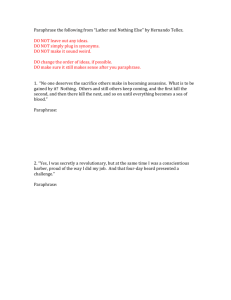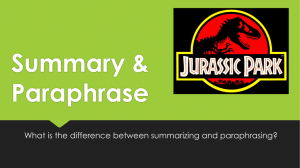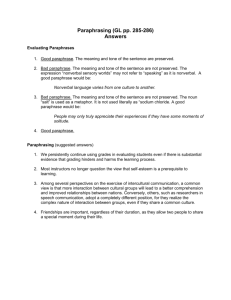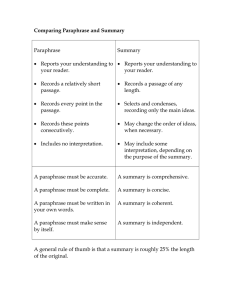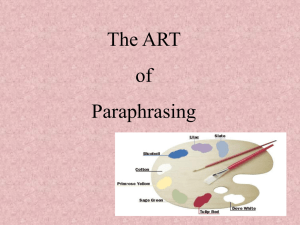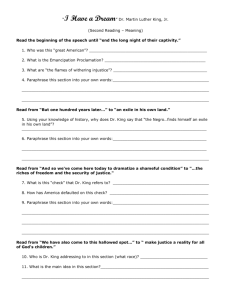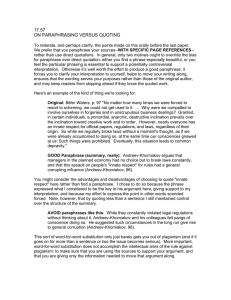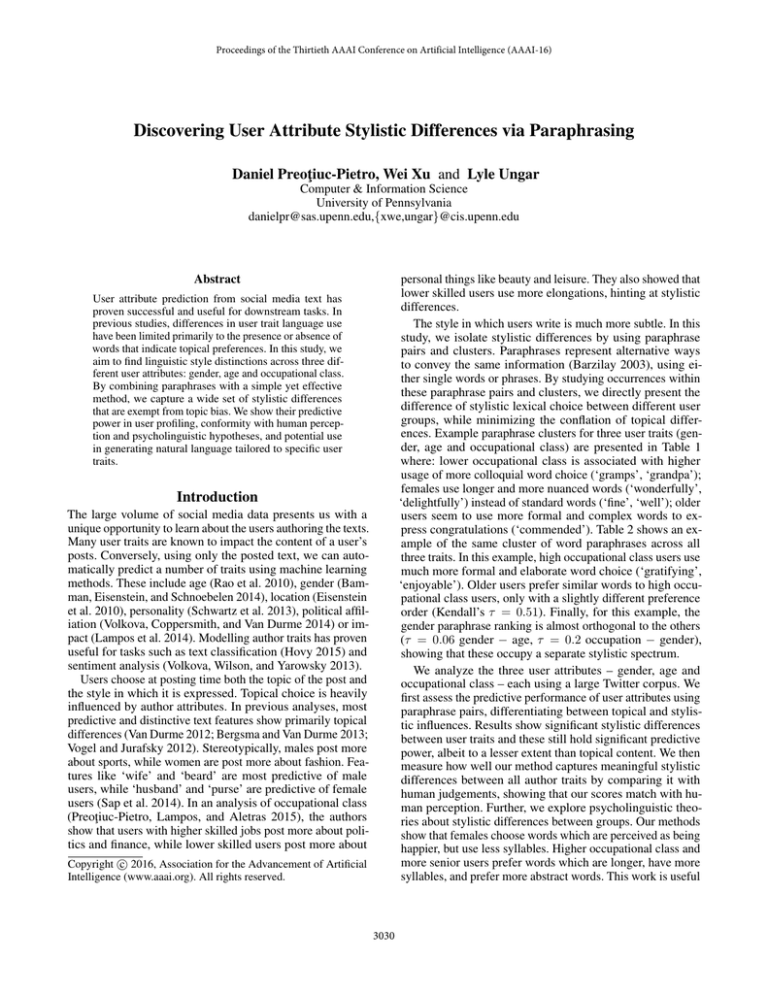
Proceedings of the Thirtieth AAAI Conference on Artificial Intelligence (AAAI-16)
Discovering User Attribute Stylistic Differences via Paraphrasing
Daniel Preoţiuc-Pietro, Wei Xu and Lyle Ungar
Computer & Information Science
University of Pennsylvania
danielpr@sas.upenn.edu,{xwe,ungar}@cis.upenn.edu
personal things like beauty and leisure. They also showed that
lower skilled users use more elongations, hinting at stylistic
differences.
The style in which users write is much more subtle. In this
study, we isolate stylistic differences by using paraphrase
pairs and clusters. Paraphrases represent alternative ways
to convey the same information (Barzilay 2003), using either single words or phrases. By studying occurrences within
these paraphrase pairs and clusters, we directly present the
difference of stylistic lexical choice between different user
groups, while minimizing the conflation of topical differences. Example paraphrase clusters for three user traits (gender, age and occupational class) are presented in Table 1
where: lower occupational class is associated with higher
usage of more colloquial word choice (‘gramps’, ‘grandpa’);
females use longer and more nuanced words (‘wonderfully’,
‘delightfully’) instead of standard words (‘fine’, ‘well’); older
users seem to use more formal and complex words to express congratulations (‘commended’). Table 2 shows an example of the same cluster of word paraphrases across all
three traits. In this example, high occupational class users use
much more formal and elaborate word choice (‘gratifying’,
‘enjoyable’). Older users prefer similar words to high occupational class users, only with a slightly different preference
order (Kendall’s τ = 0.51). Finally, for this example, the
gender paraphrase ranking is almost orthogonal to the others
(τ = 0.06 gender − age, τ = 0.2 occupation − gender),
showing that these occupy a separate stylistic spectrum.
We analyze the three user attributes – gender, age and
occupational class – each using a large Twitter corpus. We
first assess the predictive performance of user attributes using
paraphrase pairs, differentiating between topical and stylistic influences. Results show significant stylistic differences
between user traits and these still hold significant predictive
power, albeit to a lesser extent than topical content. We then
measure how well our method captures meaningful stylistic
differences between all author traits by comparing it with
human judgements, showing that our scores match with human perception. Further, we explore psycholinguistic theories about stylistic differences between groups. Our methods
show that females choose words which are perceived as being
happier, but use less syllables. Higher occupational class and
more senior users prefer words which are longer, have more
syllables, and prefer more abstract words. This work is useful
Abstract
User attribute prediction from social media text has
proven successful and useful for downstream tasks. In
previous studies, differences in user trait language use
have been limited primarily to the presence or absence of
words that indicate topical preferences. In this study, we
aim to find linguistic style distinctions across three different user attributes: gender, age and occupational class.
By combining paraphrases with a simple yet effective
method, we capture a wide set of stylistic differences
that are exempt from topic bias. We show their predictive
power in user profiling, conformity with human perception and psycholinguistic hypotheses, and potential use
in generating natural language tailored to specific user
traits.
Introduction
The large volume of social media data presents us with a
unique opportunity to learn about the users authoring the texts.
Many user traits are known to impact the content of a user’s
posts. Conversely, using only the posted text, we can automatically predict a number of traits using machine learning
methods. These include age (Rao et al. 2010), gender (Bamman, Eisenstein, and Schnoebelen 2014), location (Eisenstein
et al. 2010), personality (Schwartz et al. 2013), political affiliation (Volkova, Coppersmith, and Van Durme 2014) or impact (Lampos et al. 2014). Modelling author traits has proven
useful for tasks such as text classification (Hovy 2015) and
sentiment analysis (Volkova, Wilson, and Yarowsky 2013).
Users choose at posting time both the topic of the post and
the style in which it is expressed. Topical choice is heavily
influenced by author attributes. In previous analyses, most
predictive and distinctive text features show primarily topical
differences (Van Durme 2012; Bergsma and Van Durme 2013;
Vogel and Jurafsky 2012). Stereotypically, males post more
about sports, while women are post more about fashion. Features like ‘wife’ and ‘beard’ are most predictive of male
users, while ‘husband’ and ‘purse’ are predictive of female
users (Sap et al. 2014). In an analysis of occupational class
(Preoţiuc-Pietro, Lampos, and Aletras 2015), the authors
show that users with higher skilled jobs post more about politics and finance, while lower skilled users post more about
c 2016, Association for the Advancement of Artificial
Copyright Intelligence (www.aaai.org). All rights reserved.
3030
Gender
Age
Occupational Class
wonderfully > delightfully > beautifully > fine > well > good > nicely > superbly
applauded >commended >salute >praised >pay tribute >congratulated
grandfather > granddad > grandpa > grandad > gramps
Table 1: Example paraphrase clusters ordered by preference. Female, high occupational class and 30 years old are to the left.
Female
charming (-0.58)
delightful (-0.49)
gratifying (0.03)
splendid (0.07)
good (0.12)
pleasing (0.18)
nice (0.24)
pleasurable (0.24)
pleasant (0.33)
enjoyable (0.38)
Male
30 y.o.
delightful (-0.96)
splendid (-0.55)
enjoyable (-0.46)
gratifying (-0.04)
pleasant (0.01)
charming (0.03)
pleasurable (0.13)
nice (0.53)
good (0.53)
pleasing (0.80)
< 25 y.o.
High Occ. Class
gratifying (-0.33)
enjoyable (-0.30)
delightful (-0.17)
pleasant (-0.06)
charming (-0.04)
splendid (-0.01)
good (0.08)
nice (0.17)
pleasing (0.21)
pleasurable (0.77)
Low Occ. Class
Age
The age data set consists of 5,091 users mapped to their
real age. Their age is identified by mining posts of the type
‘Happy X birthday to @USER’ (Volkova and Bachrach 2015).
We divide the users in two groups: 30 years old (958 users)
and < 25 years old (2,907 users). The final data set consists
of 690,077 tweets.
Inducing Stylistic Paraphrases
We use the Paraphrase Database (PPDB) (Ganitkevitch,
Van Durme, and Chris Callison-Burch 2013) as our source
of paraphrases. PPDB 2.0 (Pavlick et al. 2015) contains over
100 million paraphrases derived from a large collection of
bilingual texts by pivoting methods. Each paraphrase pair
comes with ranking scores about its quality and reliance
based on a supervised regression model using distributional
similarity and other features. We use paraphrase pairs that
have an equivalence probability of at least 0.2.
Given a paraphrase pair, we use phrase (here, 1-3 grams)
occurrence statistics computed over our data sets to measure
the phrase choice difference over user attributes.To score
which user attribute (we exemplify with gender in this paragraph) favors a phrase w, we compute the scores Male(w)
and Female(w) which represent the average normalized male
and female, respectively, usage of phrase w. For each phrase
we compute a score:
Female(w)
(1)
Gender(w) = log
Male(w)
Table 2: Example paraphrase cluster ordered by gender, age
and occupational class. The number in brackets represents
the magnitude with which the word is related to each trait.
for tailoring content to users, for example in dialogue systems or targeted advertising. All paraphrase user trait scores
described in this study are openly available.1
Data
We use three Twitter data sets to extract phrase statistics. All
data is tokenised (Preoţiuc-Pietro et al. 2012), filtered for
English using the langid.py tool (Lui and Baldwin 2012) and
part-of-speech tagged using the Twitter model of the Stanford
tagger (Derczynski et al. 2013).
Gender
We use a data set consisting of 104,500,740 posts from 67,337
Twitter users (31,682 males and 35,655 females). The gold
gender labels are obtained from the users’ self-reported information in their linked accounts on other networks such as
Facebook or MySpace, a method used in (Burger et al. 2011;
Volkova, Wilson, and Yarowsky 2013).
Within a paraphrase pair (w1 , w2 ), the difference
Gender(w1 ) − Gender(w2 ) measures the stylistic distance between user trait groups. We apply the same method
for both occupational class and age. Our methodology
is similar to the work of (Pavlick and Nenkova 2015)
who studied paraphrasing in the context of formality and
complexity.
We also use paraphrases clusters that are created by using
the transitive closure of pairwise paraphrases (the paraphrase
relationship in PPDB is not symmetric). Within these clusters,
we subtract the mean phrase scores. This adjusts for topic
prevalence e.g., males swear a priori more than females, so
scores in a swear-word cluster would be skewed towards
males without this adjustment. This leads to a score of 0
representing a reference point across all clusters.
Occupational Class
This data set consists of tweets from 5,191 Twitter users labeled with one of the nine major occupational classes as given
by the UK Standard Occupational Classification (PreoţiucPietro et al. 2015). The users are spread across the nine major
classes, with the skill level required for an increasing as the
class number is lower. The data set consists of 10,796,836
tweets and was introduced in (Preoţiuc-Pietro, Lampos, and
Aletras 2015). We consider high occupational class (or higher
skilled) users to be those belonging to classes 1-2 (2,292
users) and low occupational class (or lower skilled) users
from classes 5-9 (1,617 users).
Analysing Inter-Trait Differences
We use the three data sets to perform an exploratory study
on trait similarities in terms of topic and style, the latter measured using paraphrases. We first measure the correlations
between all phrases using the score defined in the previous
1
http://figshare.com/articles/Paraphrase choice based on user
traits/1613525
3031
Traits
Age (< 25 y.o.)
Occ.Class (Low)
Occ.Class (Low) Gender (Female)
Age (< 25 y.o.)
Gender (Female)
Correlation
0.366
0.355
0.269
Traits
Age (< 25 y.o.)
Occ.Class (Low)
Age (< 25 y.o.)
Gender (Female)
Occ.Class (Low) Gender (Female)
Table 5: Average Kendall τ rank correlation between paraphrase cluster usage compared acrosst different user traits.
Spearman rank correlation ρ and Pearson correlation reveal
similar patterns.
Table 3: Pearson correlations between traits computed using
scores over all vocabulary phrases. Positive label is mentioned in brackets.
Traits
Occ.Class Gender
Age
Occ.Class
Age
Gender
Correlation
0.318
0.306
0.305
Correlation
0.241
0.178
0.162
across all clusters is presented in Table 5.
The results show, consistently to Table 3, that younger
age and lower occupational class share the most overlap in
terms of paraphrase phrase choice. The correlation between
the phrase choices of younger users and females is almost
as high as that between low occupational class users and
females. This is despite that on overall phrase usage, the
correlation between low occupational class and females was
considerably higher. The above analysis demonstrates that
stylistic paraphrase choice reveals different patterns to those
extracted by analyzing all phrases.
Table 4: Pearson correlations between paraphrase cluster
standard deviations. This highlights which traits show similar
divergent styles.
section. Results comparing all pairs of the three datasets are
presented in Table 3.
We observe that by this direct comparison using all vocabulary phrases, scores are most correlated between users
under 25 years old and users with low occupational class.
This is perhaps not surprising, as younger users are more
likely to have a job with a lower skill level. The next highest
correlation is intriguingly between low occupational class
and female gender. Lastly, female gender word scores are
also correlated with younger users to a lesser extent.
However, we turn to paraphrases and paraphrase clusters
in order to measure stylistic language choice and test if the
same patterns hold as by using all vocabulary phrases. As
exemplified in Table 2, for each trait a paraphrase cluster consists of a phrase ranking in terms of preference and the scores
reflect the divergence in usage. Within each cluster, a higher
standard deviation thus indicates a higher divergence in usage
between the two user opposing groups. The highest average
cluster standard deviation is obtained for age (μ = 0.684),
with occupational class (μ = 0.466) and gender (μ = 0.258)
considerably lower. We thus see that the highest difference in
word use is observed between age groups, perhaps partially
influenced by our choice of age groups.
We further analyze the correlations between the clusters
ranked by standard deviation in order to see which groups of
paraphrases have similar divergence. Results are shown in
Table 4.
Occupational class and gender paraphrase clusters have
the most divergent clusters in common, while age and gender
have the least, similarly to the analysis over all phrases. However, the most relevant aspect for phrase choice, is the order
in phrase preference within a paraphrase cluster. For example,
in Table 2 the paraphrase cluster is ordered very similarly
by high occupational class and by older users (Kendall’s
τ = 0.51). In this case, gender is almost orthogonal to the
other two dimensions (τ = 0.06 gender − age, τ = 0.2 occupation − gender). To analyze this in more detail, for each
paraphrase cluster we compute a measure of rank similarity
between all pairs of user traits. The average rank similarity
Predicting User Attributes
In this experiment, we test the predictive power of the set of
words part of paraphrases in comparison to all vocabulary
phrases. We randomly select 80% of the users to build probabilities for each phrase and keep 20% for use in evaluating
prediction accuracy. We use the Naı̈ve Bayes classifier to
assign a score to each user. As we evaluate our models using
ROC AUC and correlation, we do not need to estimate a prior
class distribution based on the training data. This results in
the Naı̈ve Bayes likelihood for each user and task being equal
to the dot product between the log probability of the word
belonging to one class (similar to the measure we previously
defined) and the user phrase distribution vector.
To measure the influence of paraphrase choice, we compare the performance of the full model using all phrase scores
(with a relative frequency of over 10−5 in each dataset) to
the model using only phrases appearing in at least one paraphrase pair (except for trivial paraphrases which differ only
in stopwords) and the rest of the phrases separately. The former is a proxy for stylistic choice while the latter is a proxy
for topical information. Results of evaluating the user gender
score against the true gender are shown in Table 6 in ROC
AUC (Table 6a) and point-biserial correlation (Table 6b). All
correlations are significant (p < 10−10 , two tailed t-test).
We notice some general patterns which hold across both
metrics. Overall, the phrases also part of paraphrase pairs
lead to lower performance when compared to the phrases not
part of paraphrases. However, these still hold significant prediction performance over chance, showing that they contain
important cues. For age, adding the paraphrase features improves the prediction performance significantly (∼ .04 ROC
AUC). Not coincidentally, age was the feature that showed
the highest paraphrase differences in the analysis from the
previous section. Adding paraphrase features to gender prediction leads to similar results. In the case of occupational
3032
Agreement Rate (%)
Random Baseline
Only Paraphrases
Phrases w/o Paraphrases
All phrases
Gender
0.5
0.691
0.784
0.765
Age
0.5
0.742
0.861
0.901
Occ.Class
0.5
0.700
0.870
0.795
Gender (68.5%)
(a) Area under the Receiver Operating Characteristic Curve (ROC
AUC)
Random Baseline
Only Paraphrases
Phrases w/o Paraphrases
All phrases
Gender
0
0.321
0.449
0.442
Age
0
0.354
0.513
0.579
Occupational Class (67.2%)
Occ.Class
0
0.271
0.474
0.419
Age (73.7%)
(b) Point-biserial Correlation
Examples
husband > hubby
fascinating > charming
dame > lady
comfortable > comfy
laugh > giggle
unnecessary > useless
many > alot
decline > fall
unveils > presents
proposals > suggestions
chaos > mess
impressive > amazing
victory > winning
assault > attack
excellent > great
Table 7: Agreement between human ratings and automatic
measures based on statistics over text. The words on the
left are more likely to be used by male/higher-skilled/older
people.
Table 6: User attribute prediction results. Using only paraphrases that capture more stylistic rather than topical differences between different user demographic groups, our
method still show good predictive power comparing to using
all phrase (1-3 grams) features.
Disagreement Rate (%)
class predictions, actually adding these features hurts predictive performance. With respect to author trait prediction
performance, age is also easiest to classify (.901 ROC AUC),
followed by occupational class (.870 ROC AUC) and gender
(.784 ROC AUC).
Gender (25.8%)
Occupational Class (30.3%)
Age (24.0%)
Human Perception of Writing Style
We perform a crowdsourcing experiment in order to validate
our measure of stylistic difference within paraphrase pairs
and check if this perceptible to human raters. We use the
paraphrase scores as a indicator of stylistic divergence and
for each user trait, we present a random set of 100 paraphrase
pairs with a difference larger than 0.2 to the workers to rate.
Each paraphrase pair was rated by 5 workers on Amazon Mechanical Turk (MTurk). The workers were asked
to pick which phrase they think is more likely used by a
female/higher skilled/older user rather than a male/lower
skilled/younger user. To eliminate possible biases, we randomized the order of the two phrases in a paraphrase pair
when presenting them to different workers.
Overall, in around 70% of the pairs (see Table 7), the majority vote of human annotators agrees with the automatic
measures described in the previous sections. This demonstrates that differences in word choice are perceptible by
humans and can be traced to different user traits. The highest
agreement was with respect to age (73.3%), again highlighting that age carries the largest stylistic differences. Similarly
to the prediction results, occupational class differences were
the lowest, although still significantly above chance. Table
7 shows some examples of paraphrases correctly rated by
crowdsourcing workers. Table 8 shows some representative
examples where our automatic rating is different from human judgements. Many disagreements are caused by word
polysemy (e.g. ‘classes’) or shortening (e.g. ‘yrs’) or rating
out-of-context (e.g. ‘legend’). The inter-annotator agreements
between crowdsourcing workers are on the low side but not
Examples (human rating)
okay > nice
handmade > homemade
fierce > brutal
humour > wit
story > legend
indie > independent
classes > groups
years > yrs
protective > defensive
Table 8: Disagreement between human ratings and automatic
measures based on statistics over text. The words on the
left are more likely to be used by male/higher-skilled/older
people according to human raters. A small proportion of word
pairs (≈ 5%) received ambiguous human judgements and are
excluded from Table 7 and 8.
out of norm for capturing the subtle linguistic style difference:
Fleiss’ Kappa κ = 0.110, 0.402, 0.242 for gender, occupational class and age respectively. Further selection of crowdsourcing workers may improve the rating reliability (Gao et
al. 2015), which we leave for future work.
Linguistic Hypotheses
We investigate a number of psycholinguistic hypotheses
about phrase choice and style by using our paraphrase based
method. We argue the phrase choice within a paraphrase pair
excludes the topical influence that confounds studies using all
words (Sarawgi, Gajulapalli, and Choi 2011). Using unigram
paraphrases we study if any user group is more likely to use
a word based on the following properties:
Word length We compute the difference in word length in
a paraphrase pair as a simple proxy for word complexity.
3033
Feature
Word length
#Syllables
Word rareness
Happiness
Concreteness
Gender
.089**
.047**
-.053**
-.051**
-.048**
Age
.158**
.077**
-.028**
-.022*
-.037**
Occ.Class
.211**
.110**
-.034**
-.026*
-.124**
Most intriguingly, males choose the least happier word
in a paraphrase pair. It is commonly stated (Mehl and Pennebaker 2003) that males both use less references to positive
emotions and use more negative emotion words. Here, we
show that this holds for words which are not necessarily a
direct expression of an emotion. We also see that the mean
pair happiness is correlated with the female score (r = 0.068,
p < .001) and with the difference in happiness (r = 0.027,
p < .01) i.e., pairs with higher happiness are both more polarizing between genders and, to a lesser degree, register larger
differences in happiness. Figure 1 presents all paraphrase
pairs with preserving pair order (first word is more feminine).
We observe that most points have both very similar x-axis
score (not polarizing enough between genders) and similar
y-axis scores (it is expected that paraphrases which express
the same concept to have similar happiness ratings). We highlight word pairs that are illustrative for all cases e.g., ‘dip’
is more feminine than ‘decline’ and is perceived happier (or
not as bad in this case), while ‘gorgeous’ and ‘super’ are
perceived similarly happy, but are polarize across genders.
Most importantly, there is a significant correlation between
female score and perceived happiness as illustrated by the
positive slope of the correlation line.
Table 9: Correlation coefficients between paraphrase pair
word differences and user group differences in usage. The
positive class is male (for gender), higher skill level (for
occupational class) and users 30 years old (for age). p <
0.05∗ , p < 0.001∗∗ , two tailed t-test.
Number of syllables We compute the difference in the
number of syllables in a paraphrase pair as another proxy for
word complexity.
Word rareness We use a reference corpus consisting of
∼ 400 million tweets to measure word frequencies. By computing a frequency ratio for each pair, we measure which
word from a pair is more frequently used overall.
For age, we observe that the older users prefer words that
are longer in number of characters and syllables. This is
expected, as vocabulary complexity increases with age. For
happiness, we observe that younger users prefer words that
sound happier, albeit less strongly correlated than in the case
of gender. This is against previous psychology research that
mentions an ageing positivity bias (Kern et al. 2014). Younger
users also prefer words which are more concrete.
Perceived happiness To obtain happiness ratings for
words we use the Hedonometer (Dodds et al. 2011; 2015).
This consists of crowdsourced happiness ratings for 10,221 of
the most frequent English words. The ratings range between
8.5 and 1.3 (m = 5.37, σ = 1.08). Note these do not only infer the emotional polarity of words (e.g., ‘happiness’ is more
positive than ‘terror’), but also how words are perceived by
the reader individually without text context (e.g., ‘mommy’
is perceived happier than ‘mom’).
Regarding occupational class, we show that users with
higher class use both longer words and words with more
syllables, showing a higher language complexity. We note
that these are the highest correlations for these two measures,
demonstrating that occupational class influences word and
syllable length more than gender or age. Users with a lower
occupational class choose words which are happier and, to a
much larger extent, more concrete. According to the model
for psychological distance (Trope and Liberman 2010), abstract thinking is associated with how far people get from
their own, immediate circumstances. As higher occupational
class users use Twitter more professionally and less interpersonally (Preoţiuc-Pietro et al. 2015), the word choice of these
users is more abstract. Rare word usage is associated with females and, to a lesser extent, with younger and lower skilled
users. Rare word usage is likely to conflate lexical innovation,
non-standard forms and specialised in-vocabulary words. To
investigate in more detail, we measure diversity in language
choice. We compute the average entropy of word use within
a cluster for each attribute, with higher entropy if the phrase
choice distribution is more uniform and thus, more diverse.
Using the entropy, we uncover that higher skilled users are
most diverse (μ = .794), followed by males (μ = 0.779)
and older users (μ = 0.765). Females (μ = 0.753), lower
skilled users (μ = 0.742) and, most importantly, younger
users (μ = 0.683) have lower entropies, revealing that they
are less flexible in phrase choice.
Concreteness Concreteness evaluates the degree to which
the concept denoted by a word refers to a perceptible entity (Brysbaert, Warriner, and Kuperman 2013). Although the
paraphrase pairs refer to the same entity, some words are perceived as more concrete (or conversely more abstract) than
others. The dual-coding theory posits that concrete words are
more easily learned, remembered and processed than abstract
words (Paivio 1971). We use a list of 37,058 English words
with crowdsourced ratings of concreteness on a scale from 5
(e.g., ‘tiger’ – 5) to 1 (e.g., ‘spirituality’ – 1.07) introduced
in (Brysbaert, Warriner, and Kuperman 2013).
Results
The Pearson correlation results are shown in Table 9. We
observe there are significant differences in paraphrase choice
between user groups.
Males use words with slightly more characters and syllables, a fact previously claimed in (Mehl and Pennebaker
2003). On the other hand, females use more concrete options within paraphrase pairs. Previous studies (Newman et
al. 2008) state that females are more likely to write about psychological states, while males are more likely to write about
conceptual things, all of which are related to abstractness.
3034
Female
Male
Female
Male
Older
Younger
Older
Younger
@USER A teeny tiny cute coffee shop (and a cheap fry-up style cafe). I’m intrigued...
@USER A small tiny clever coffee shop (and a cheap fry-up style cafe). I’m intrigued...
Well, this gorgeous video of St. Petersburg got me very excited or my trip (2 weeks to go!)
Well, this superb video of St. Petersburg got me prohibitively aroused or my journey (2 weeks to go!)
hilton worldwide launches its largest global career event URL #csr
hilton worldwide starts its biggest global career event URL #csr
rt @USER : how your body responds to exercise over time URL
rt @USER : how your body answers to workout over time URL
Table 10: Example of tweets and their automatically generated counterparts. Can you guess which are the original tweets?
(gender, occupational class and age) to be more blurry and
subtle than that of a specific speaker (Mizukami et al. 2015)
or a specific writer (Xu et al. 2012) than were captured by
language models in previous work. A more sophisticated
text-to-text generation system use parallel data (Xu, Ritter,
and Grishman 2013) and feature-rich paraphrase rules may
help solve these two problems (Ganitkevitch et al. 2011) and
thus leave this for future work.
Conclusions
User attribute differences exist at a stylistic dimension. We
have presented the first attempt to capture these by using a
method build on paraphrase choice combined with statistics
computed from vast volumes of social media text. We have
shown that significant changes exist at the phrase choice level
and these are both predictive of the user traits and intuitive
to human annotators. Our analysis can be generalised easily
to other user attributes for which large user-centered data
sets are available such as location (Cheng, Caverlee, and Lee
2010) or personality (Schwartz et al. 2013).
Our methods can be further improved by using better paraphrasing (Wieting et al. 2015) or word senses (Apidianaki,
Verzeni, and McCarthy 2014) to adjust for paraphrases which
may be skewed by a sense which is topical e.g., ‘collapse’
– ‘crumble’. We have used PPDB 2.0, a general purpose
paraphrase resource for computing paraphrase pairs. Highquality large-scale Twitter-specific paraphrase resources are
still scarce, but methods such as (Xu, Ritter, and Grishman
2013) should provide a more detailed view of stylistic difference. A future model can also include attribute labels as a
variable in the paraphrase extraction phase. In this study we
have solely relied on statistics computed over very large data
sets.
Figure 1: Scatter plot showing best fit line between gender
paraphrase use differences and differences in perceived word
happiness. Each dot is a paraphrase pair. The first word in
pair is the more feminine one.
Simulating Writing Style
We consider a interesting application of our work to be forging gender or other traits by manipulating phrase choice. As
a proof of concept, we build upon previous work of stylistic
paraphrasing (Xu et al. 2012; Mizukami et al. 2015), which
was originally conceived for translation from contemporary
modern English to Shakespearean style, or for translation of
spoken text towards an individual speaker’s style. We use the
phrase-based statistical machine translation decoder Moses
(Koehn et al. 2007) to combine a translation model of the
stylistic paraphrases uncovered by our scoring function and
a language model of the targeted demographic group. This
method essentially performs lexical substitution while taking
context into account. Table 10 shows examples that substitute
the words highly scored of one gender for counterparts of
the opposite gender. The original tweets are the top ones and
their automatically generated counterparts the bottom ones;
it’s not easy to tell apart the ‘fake’ ones and most preserve
grammaticality and meaning.
Although this preliminary system can successfully alter the
style of tweets and preserve grammaticality within certain
bounds, we found that perceptions are still dominated by
topical information and are hard to rate individually for user
traits. We also found writing style of a demographic group
Acknowledgments
Daniel Preoţiuc-Pietro and Lyle Ungar acknowledge the support of the Templeton Religion Trust, grant TRT-0048. Wei
Xu acknowledges the support of the NSF grant IIS-1430651
and the Google Faculty Research Award awarded to Chris
Callison-Burch. The views and conclusions contained in this
publication are those of the authors and should not be interpreted as representing official policies or endorsements of the
NSF or the U.S. Government. We thank the reviewers and
the senior program chair for valuable feedback.
3035
References
Ganitkevitch, J.; Van Durme, B.; and Chris Callison-Burch,
C. 2013. PPDB: The paraphrase database. In Proceedings of
the 2013 Annual Conference of the North American Chapter
of the Association for Computational Linguistics, NAACL,
758–764.
Mingkun Gao and Wei Xu and Chris Callison-Burch 2015.
Cost Optimization in Crowdsourcing Translation. In Proceedings of the 2015 Annual Conference of the North American
Chapter of the Association for Computational Linguistics,
NAACL, 705–713.
Haas, A. 1979. Male and female spoken language differences:
Stereotypes and evidence. Psychological Bulletin 86:616–
626.
Han, B.; Cook, P.; and Baldwin, T. 2012. Automatically constructing a normalisation dictionary for microblogs. In Proceedings of the 2012 Joint Conference on Empirical Methods
in Natural Language Processing and Computational Natural
Language Learning, EMNLP, 421–432.
Hovy, D. 2015. Demographic factors improve classification
performance. In Proceedings of the 53rd Annual Meeting
of the Association for Computational Linguistics, ACL, 752762.
Kern, M. L.; Eichstaedt, J. C.; Schwartz, H. A.; Park, G.;
Ungar, L. H.; Stillwell, D. J.; Kosinski, M.; Dziurzynski,
L.; and Seligman, M. E. 2014. Developmental Psychology
50:178–188.
Koehn, P.; Hoang, H.; Birch, A.; Callison-Burch, C.; Federico, M.; Bertoldi, N.; Cowan, B.; Shen, W.; Moran, C.;
Zens, R.; et al. 2007. Moses: Open source toolkit for statistical machine translation. In Proceedings of the 45th annual
meeting of the Association for Computational Linguistics
(Demo), 177–180.
Lampos, V.; Aletras, N.; Preoţiuc-Pietro, D.; and Cohn, T.
2014. Predicting and characterising user impact on Twitter. In
Proceedings of the 14th Conference of the European Chapter
of the Association for Computational Linguistics, EACL,
405–413.
Lui, M., and Baldwin, T. 2012. langid.py: An off-the-shelf
language identification tool. In Proceedings of the 50th Annual Meeting of the Association for Computational Linguistics, ACL, 25–30.
Mehl, M. R., and Pennebaker, J. W. 2003. The sounds
of social life: A psychometric analysis of students’ daily
social environments and natural conversations. Journal of
Personality and Social Psychology 84(4):857–870.
Mizukami, M.; Neubig, G.; Sakti, S.; Toda, T.; and Nakamura, S. 2015. Linguistic individuality transformation for
spoken language. In Natural Language Dialog Systems and
Intelligent Assistants, 129–143.
Newman, M. L.; Groom, C. J.; Handelman, L. D.; and Pennebaker, J. W. 2008. Gender differences in language use:
An analysis of 14,000 text samples. Discourse Processes
45(3):211–236.
Paivio, A.; 1971. Imagery and verbal processes. New York:
Holt, Rinchart, and Winston.
Apidianaki, M.; Verzeni, E.; and McCarthy, D. 2014. Semantic clustering of pivot paraphrases. In Proceedings of the
Ninth International Conference on Language Resources and
Evaluation, LREC, 4270–4275.
Bamman, D.; Eisenstein, J.; and Schnoebelen, T. 2014. Gender identity and lexical variation in social media. Journal of
Sociolinguistics 18(2):135–160.
Barzilay, R. 2003. Information fusion for multidocument
summarization: Paraphrasing and generation. Ph.D. Dissertation.
Bergsma, S., and Van Durme, B. 2013. Using conceptual
class attributes to characterize social media users. In Proceedings of the 51st Annual Meeting of the Association for
Computational Linguistics, ACL, 710–720.
Brysbaert, M., and Warriner, A.B. and Kuperman, V. 2014.
Concreteness ratings for 40 thousand generally known English word lemmas. Behavior Research Methods , 46(3):904–
911.
Burger, D. J.; Henderson, J.; Kim, G.; and Zarrella, G. 2011.
Discriminating gender on Twitter. In Proceedings of the
2011 Conference on Empirical Methods in Natural Language
Processing, EMNLP, 11–1309.
Cheng, Z.; Caverlee, J.; and Lee, K. 2010. You are where
you tweet: A content-based approach to geo-locating Twitter users. In Proceedings of the 19th ACM Conference on
Information and Knowledge Management, CIKM, 759–768.
Danescu-Niculescu-Mizil, C.; Lee, L.; Pang, B.; and Kleinberg, J. 2012. Echoes of power: Language effects and power
differences in social interaction. In Proceedings of the 21st
international conference on World Wide Web, WWW, 699–
708.
Derczynski, L.; Ritter, A.; Clark, S.; and Bontcheva, K. 2013.
Twitter part-of-speech tagging for all: Overcoming sparse and
noisy data. In Proceedings of the International Conference on
Recent Advances in Natural Language Processing, RANLP,
198–206.
Dodds, P. S.; Harris, K. D.; Kloumann, I. M.; Bliss, C. A.;
and Danforth, C. M. 2011. Temporal patterns of happiness
and information in a global social network: Hedonometrics
and Twitter. PLoS One 6 (12).
Dodds, P. S.; Clark, E. M.; Desu, S.; Frank, M. R.; Reagan,
A. J.; Williams, J. R.; Mitchell, L.; Harris, K. D.; Kloumann,
I. M.; Bagrow, J. P.; Megerdoomian, K.; McMahon, M. T.;
Tivnan, B. F.; and Danforth, C. M. 2015. Human language reveals a universal positivity bias. Proceedings of the National
Academy of Sciences 112(8):2389–2394.
Eisenstein, J.; O’Connor, B.; Smith, N. A.; and Xing, E. P.
2010. A latent variable model for geographic lexical variation.
In Proceedings of the Conference on Empirical Methods in
Natural Language Processing, EMNLP, 1277–1287.
Ganitkevitch, J.; Callison-Burch, C.; Napoles, C.; and
Van Durme, B. 2011. Learning sentential paraphrases from
bilingual parallel corpora for text-to-text generation. In Proceedings of the Conference on Empirical Methods in Natural
Language Processing, EMNLP, 1168–1179.
3036
Pavlick, E., and Nenkova, A. 2015. Inducing lexical style
properties for paraphrase and genre differentiation. In Proceedings of the 2015 Annual Conference of the North American Chapter of the Association for Computational Linguistics,
NAACL, 218–224.
Pavlick, E.; Bos, J.; Nissim, M.; Beller, C.; Van Durme, B.;
and Callison-Burch, C. 2015. Adding semantics to datadriven paraphrasing. In Proceedings of the 53rd Annual
Meeting of the Association for Computational Linguistics,
ACL, 1512–1522.
Preoţiuc-Pietro, D.; Samangooei, S.; Cohn, T.; Gibbins, N.;
and Niranjan, M. 2012. Trendminer: an architecture for real
time analysis of social media text. In Proceedings of the 6th
International AAAI Conference on Weblogs and Social Media, Workshop on Real-Time Analysis and Mining of Social
Streams, ICWSM, 38–42.
Preoţiuc-Pietro, D.; Volkova, S.; Lampos, V.; Bachrach, Y.;
and Aletras, N. 2015. Studying user income through language, behaviour and affect in social media. PLoS ONE 10
(9).
Preoţiuc-Pietro, D.; Lampos, V.; and Aletras, N. 2015. An
analysis of the user occupational class through Twitter content. In Proceedings of the 53rd Annual Meeting of the
Association for Computational Linguistics, ACL.
Rao, D.; Yarowsky, D.; Shreevats, A.; and Gupta, M. 2010.
Classifying latent user attributes in Twitter. In Proceedings
of the 2nd International Workshop on Search and Mining
User-generated Contents, SMUC, 37–44.
Sap, M.; Park, G.; Eichstaedt, J.; Kern, M.; Ungar, L.; and
Schwartz, H. A. 2014. Developing age and gender predictive
lexica over social media. In Proceedings of the 2014 Conference on Empirical Methods in Natural Language Processing,
EMNLP, 1146–1151.
Sarawgi, R.; Gajulapalli, K.; and Choi, Y. 2011. Gender attribution: Tracing stylometric evidence beyond topic and genre.
In Proceedings of the Fifteenth Conference on Computational
Natural Language Learning, CoNNL, 78–86.
Schwartz, H. A.; Eichstaedt, J. C.; Kern, M. L.; Dziurzynski, L.; Ramones, S. M.; Agrawal, M.; Shah, A.; Kosinski,
M.; Stillwell, D.; Seligman, M. E.; and Ungar, L. H. 2013.
Personality, gender, and age in the language of social media:
The open-vocabulary approach. PLoS One, 8 (9).
Trope, Y., and Liberman, N. 2010. Construal-level theory of
psychological distance. Psychological Review, 117(2), 440.
Van Durme, B. 2012. Streaming analysis of discourse participants. In Proceedings of the 2012 Joint Conference on
Empirical Methods in Natural Language Processing and
Computational Natural Language Learning, EMNLP, 48–58.
Vogel, A., and Jurafsky, D. 2012. He said, she said: Gender
in the acl anthology. In Proceedings of the Special Workshop
on Rediscovering 50 Years of Discoveries, ACL, 33–41.
Volkova, S., and Bachrach, Y. 2015. On predicting sociodemographic traits and emotions in social networks and implications to online self-disclosure. Cyberpsychology, Behavior,
and Social Networking, To appear.
Volkova, S.; Coppersmith, G.; and Van Durme, B. 2014.
Inferring user political preferences from streaming communications. In Proceedings of the 52nd Annual Meeting of the
Association for Computational Linguistics, ACL, 186–196.
Volkova, S.; Wilson, T.; and Yarowsky, D. 2013. Exploring
demographic language variations to improve multilingual
sentiment analysis in social media. In Proceedings of the
2013 Conference on Empirical Methods in Natural Language
Processing, EMNLP, 1815–1827.
Wieting, J.; Bansal, M.; Gimpel, K.; and Livescu, K. 2015.
From paraphrase database to compositional paraphrase model
and back. Transactions of the Association for Computational
Linguistics, TACL, 345–358.
Xu, W.; Ritter, A.; Dolan, B.; Grishman, R.; and Cherry,
C. 2012. Paraphrasing for style. In Proceedings of the
24th International Conference on Computational Linguistics,
COLING, 2899–2914.
Xu, W.; Ritter, A.; and Grishman, R. 2013. Gathering and
generating paraphrases from Twitter with application to normalization. In Proceedings of the Sixth Workshop on Building
and Using Comparable Corpora, BUCC, 121–128.
3037

